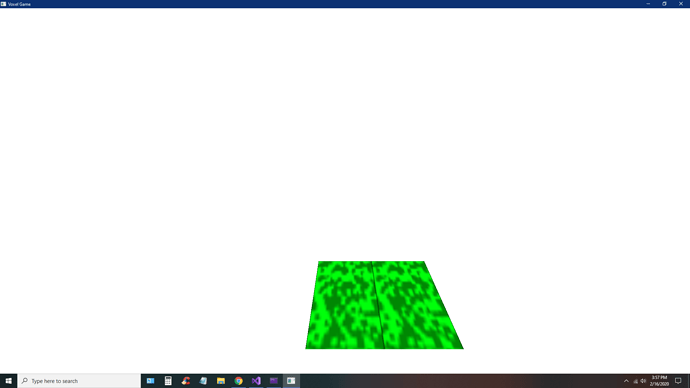My program renders two squares side by side. I am trying to implement a projection matrix into the mix but it won’t work. When I multiply it by the vector in the vertex shader, I get nothing.
#include <iostream>
#include "glad/glad.h"
#include "GLFW/glfw3.h"
#include "glm/glm.hpp"
#include "glm/ext.hpp"
#include "glm/gtc/matrix_transform.hpp"
#include "SOIL.h"
#define out std::cout
#define end std::endl
const GLchar *vertexShaderSource = R"(
#version 330 core
layout (location = 0) in vec3 pos;
layout (location = 1) in vec2 coord;
out vec2 TexCoord;
uniform float aspect_ratio;
uniform mat4 model;
uniform mat4 view;
uniform mat4 projection;
void main()
{
gl_Position = projection * vec4(pos.x, pos.y, pos.z, 1.0);
TexCoord = coord;
}
)";
const GLchar *fragmentShaderSource = R"(
#version 330 core
in vec2 TexCoord;
out vec4 Color;
uniform sampler2D ourTexture;
void main()
{
//Color = vec4(1.0, 0.5, 0.2, 1.0);
Color = texture(ourTexture, TexCoord);
}
)";
void framebuffer_size_callback(GLFWwindow*, GLint, GLint);
int render(GLFWwindow*, GLuint, GLuint);
void buffer(GLuint&, GLuint&, GLuint&, float [], unsigned int []);
void shader(GLuint, GLuint);
void processInput(GLFWwindow*);
GLuint shaderProgram;
/* Flow
main -> render -> shader -> processInputs
*/
int main()
{
glfwInit();
glfwWindowHint(GLFW_CONTEXT_VERSION_MAJOR, 3);
glfwWindowHint(GLFW_CONTEXT_VERSION_MINOR, 3);
glfwWindowHint(GLFW_OPENGL_PROFILE, GLFW_OPENGL_CORE_PROFILE);
glfwWindowHint(GLFW_RESIZABLE, GL_TRUE);
GLFWwindow *window = glfwCreateWindow(1280, 720, "Voxel Game", NULL, NULL);
if (!window)
{
out << "Failed to create GLFW window" << end;
glfwTerminate();
return -1;
}
else
{
glfwMakeContextCurrent(window);
glfwSetFramebufferSizeCallback(window, framebuffer_size_callback);
}
gladLoadGL();
if (!gladLoadGLLoader((GLADloadproc)glfwGetProcAddress))
{
out << "Failed to initialize GLAD" << end;
return -1;
}
const GLFWvidmode* mode = glfwGetVideoMode(glfwGetPrimaryMonitor());
GLint window_width = mode->width;
GLint window_height = mode->height;
render(window, window_width, window_height);
return 0;
}
int render(GLFWwindow *window, GLuint window_width, GLuint window_height)
{
float vertices[] =
{
// positions // texture coords
0.2f, 0.2f, 0.0f, 1.0f, 1.0f, // top right
0.2f, -0.2f, 0.0f, 1.0f, 0.0f, // bottom right
-0.2f, -0.2f, 0.0f, 0.0f, 0.0f, // bottom left
-0.2f, 0.2f, 0.0f, 0.0f, 1.0f // top left
};
float vertices2[] =
{
// positions // texture coords
0.6f, 0.2f, 0.0f, 1.0f, 1.0f, // top right
0.6f, -0.2f, 0.0f, 1.0f, 0.0f, // bottom right
0.2f, -0.2f, 0.0f, 0.0f, 0.0f, // bottom left
0.2f, 0.2f, 0.0f, 0.0f, 1.0f // top left
};
unsigned int indices[] =
{
0, 1, 3, // first triangle
1, 2, 3 // second triangle
};
// Vertex Array, Vertex Buffer and Element Buffer
GLuint VAO[2], VBO[2], EBO[2];
glGenVertexArrays(2, VAO);
glGenBuffers(2, VBO);
glGenBuffers(2, EBO);
glBindVertexArray(VAO[0]);
glBindBuffer(GL_ARRAY_BUFFER, VBO[0]);
glBufferData(GL_ARRAY_BUFFER, sizeof(vertices), vertices, GL_STATIC_DRAW);
glBindBuffer(GL_ELEMENT_ARRAY_BUFFER, EBO[0]);
glBufferData(GL_ELEMENT_ARRAY_BUFFER, sizeof(indices), indices, GL_STATIC_DRAW);
glVertexAttribPointer(0, 3, GL_FLOAT, GL_FALSE, 5 * sizeof(float), (void*)0);
glEnableVertexAttribArray(0);
glVertexAttribPointer(1, 2, GL_FLOAT, GL_FALSE, 5 * sizeof(float), (void*)(3 * sizeof(float)));
glEnableVertexAttribArray(1);
glBindVertexArray(VAO[1]);
glBindBuffer(GL_ARRAY_BUFFER, VBO[1]);
glBufferData(GL_ARRAY_BUFFER, sizeof(vertices2), vertices2, GL_STATIC_DRAW);
glBindBuffer(GL_ELEMENT_ARRAY_BUFFER, EBO[1]);
glBufferData(GL_ELEMENT_ARRAY_BUFFER, sizeof(indices), indices, GL_STATIC_DRAW);
glVertexAttribPointer(0, 3, GL_FLOAT, GL_FALSE, 5 * sizeof(float), (void*)0);
glEnableVertexAttribArray(0);
glVertexAttribPointer(1, 2, GL_FLOAT, GL_FALSE, 5 * sizeof(float), (void*)(3 * sizeof(float)));
glEnableVertexAttribArray(1);
shader(window_width, window_height);
// Load Image
int width, height, channels;
unsigned char *image = SOIL_load_image("grass.png", &width, &height, &channels, SOIL_LOAD_RGB);
// Texture
unsigned int texture;
glGenTextures(1, &texture);
glBindTexture(GL_TEXTURE_2D, texture);
// Settings
glTexParameteri(GL_TEXTURE_2D, GL_TEXTURE_WRAP_S, GL_CLAMP_TO_BORDER);
// Texture Image
if (image)
{
glTexImage2D(GL_TEXTURE_2D, 0, GL_RGB, width, height, 0, GL_RGB, GL_UNSIGNED_BYTE, image);
glGenerateMipmap(GL_TEXTURE_2D);
}
else
{
out << "Failed to load texture" << end;
}
SOIL_free_image_data(image);
// Render Loop
while (!glfwWindowShouldClose(window))
{
processInput(window);
glClearColor(1.0f, 1.0f, 1.0f, 1.0f);
glClear(GL_COLOR_BUFFER_BIT);
//glBindTexture(GL_TEXTURE_2D, texture);
//glUseProgram(shaderProgram);
glBindVertexArray(VAO[0]);
glDrawElements(GL_TRIANGLES, 6, GL_UNSIGNED_INT, 0); // 6 = Number of vertices (3 for each triangle)
glBindVertexArray(VAO[1]);
glDrawElements(GL_TRIANGLES, 6, GL_UNSIGNED_INT, 0);
glfwSwapBuffers(window);
glfwPollEvents();
}
glDeleteVertexArrays(2, VAO);
glDeleteBuffers(2, VBO);
glfwTerminate();
return 0;
}
void shader(GLuint window_width, GLuint window_height)
{
GLuint vertexShader = glCreateShader(GL_VERTEX_SHADER);
glShaderSource(vertexShader, 1, &vertexShaderSource, NULL);
glCompileShader(vertexShader);
GLuint fragmentShader = glCreateShader(GL_FRAGMENT_SHADER);
glShaderSource(fragmentShader, 1, &fragmentShaderSource, NULL);
glCompileShader(fragmentShader);
shaderProgram = glCreateProgram();
glAttachShader(shaderProgram, vertexShader);
glAttachShader(shaderProgram, fragmentShader);
glLinkProgram(shaderProgram);
glUseProgram(shaderProgram);
GLuint location = glGetUniformLocation(shaderProgram, "aspect_ratio");
glUniform1f(location, window_width / (float)window_height);
glm::mat4 model = glm::mat4(1.0f); // make sure to initialize matrix to identity matrix first
glm::mat4 view = glm::mat4(1.0f);
glm::mat4 projection = glm::perspective(glm::radians(180.0f), window_width / (float)window_height, 0.1f, 100.0f);
// retrieve the matrix uniform locations
GLuint modelLoc = glGetUniformLocation(shaderProgram, "model");
GLuint viewLoc = glGetUniformLocation(shaderProgram, "view");
GLuint projectionLoc = glGetUniformLocation(shaderProgram, "projection");
// pass them to the shaders (3 different ways)
glUniformMatrix4fv(modelLoc, 1, GL_FALSE, glm::value_ptr(model));
glUniformMatrix4fv(viewLoc, 1, GL_FALSE, glm::value_ptr(view));
glUniformMatrix4fv(projectionLoc, 1, GL_FALSE, glm::value_ptr(projection));
glDeleteShader(vertexShader);
glDeleteShader(fragmentShader);
}
void processInput(GLFWwindow* window)
{
if (glfwGetKey(window, GLFW_KEY_ESCAPE) == GLFW_PRESS) glfwSetWindowShouldClose(window, true);
}
void framebuffer_size_callback(GLFWwindow* window, GLint width, GLint height)
{
glViewport(0, 0, width, height);
}



